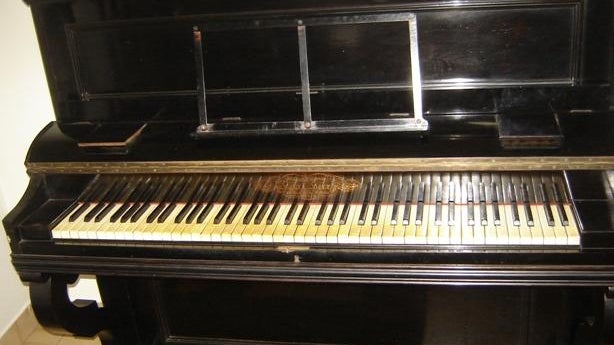“Graciosa, Land of Pianos” by Victor Rui Dores
Translated into English by Katharine F. Baker
Graciosa’s distinctiveness has always been marked by a very strong pianistic tradition. The abundance of pianos on the island was so great that in 1940 Hipólito Raposo, in political exile on the White Island, would be moved to write in his book Descobrindo Ilhas Descobertas [Discovering Discovered Islands] (Lisbon, 1942) that Graciosans owned “more pianos than sewing machines.” And this was at a time when a sewing machine was a possession of the utmost necessity.
But let’s start at the beginning – and in the beginning was the wine.
In 1589 George Clifford, 3rd Earl of Cumberland, reported that there was more wine than water on Graciosa. In fact, wine production was the island’s greatest source of wealth until the end of the 19th century. This entire period of economic prosperity provided Graciosa’s property-owning elites with an unlimited financial boom. They were a landed gentry consisting mainly of morgados [aristocrats] and other rich people, who for family or professional reasons would frequently leave the island, coming into contact with the current trends in Angra do Heroísmo, Horta, Ponta Delgada and Lisbon.
It was these morgados who brought the first pianos to Graciosa. At the end of the 19th century a second wave of pianos arrived, in an influx supported economically by a bourgeoisie who invested in whaling, the tile industry and grain production – as well as the return to the island of several emigrants from Brazil who brought customs, fashions and influences in several genres, including music.
These pianos were part of family legacies spanning time and generations. The taste for this instrument never stopped being cultivated on Graciosa, climbing to an average of one piano for every 50 inhabitants. Even each lower middle class family had its own piano. And not only them. The story of a father who sacrificed his privileged means of transport, a donkey, in order to cover the purchase price of a piano for his daughter has long resided in part of Graciosa’s imagination.
Today there must be about 100 pianos on Graciosa, which for a population not exceeding 4,000 inhabitants is still an impressive average. True, more than half these pianos are used only as decor nowadays, but what’s certain is that they are there, bearing witness to a great musical tradition.
In earlier times the piano essentially served female musical tastes, and for that reason was played mainly by girls being raised for a life of modesty, arts and crafts, and proper manners. Knowing how to play piano was an asset, as it was a mark of social distinction and enhanced many types of convivial gatherings. I know whereof I speak, because my mother gave private piano lessons to privileged girls in the village of Santa Cruz on Graciosa. I grew up listening to our home piano being pounded all day long. I’m still from a time when a single piano at sociedades recreativas [social clubs] (played by the inescapable José Berto) was enough for a dance to start. And I danced often to the sounds of waltzes, tangos, songs, polkas, foxtrots, paso-dobles, marches and the Charleston.
Dances, whether public or private, were conducive to socializing and fostered courtship with their vast repertoires, at a time when the piano industry was at its peak in America and Europe. That is to say, dancing was then a pretext and unique opportunity for couples to have contact and hold one another, with dancing serving as a type of romantic prelude. And this practice continued among us for a long time, I would say at least until the time of my adolescence on Terceira (who can forget the flame of slow-dancing at high school proms?).
I shall not let today end without playing Strauss’s “Blue Danube” waltz on the piano!
.-.-.-.-.-.-.-.-.-.-.-.-.-.-.-.-.-.-.-.-.-.-.-.-
Note Originally published in Diário Insular, 2 September 2017




